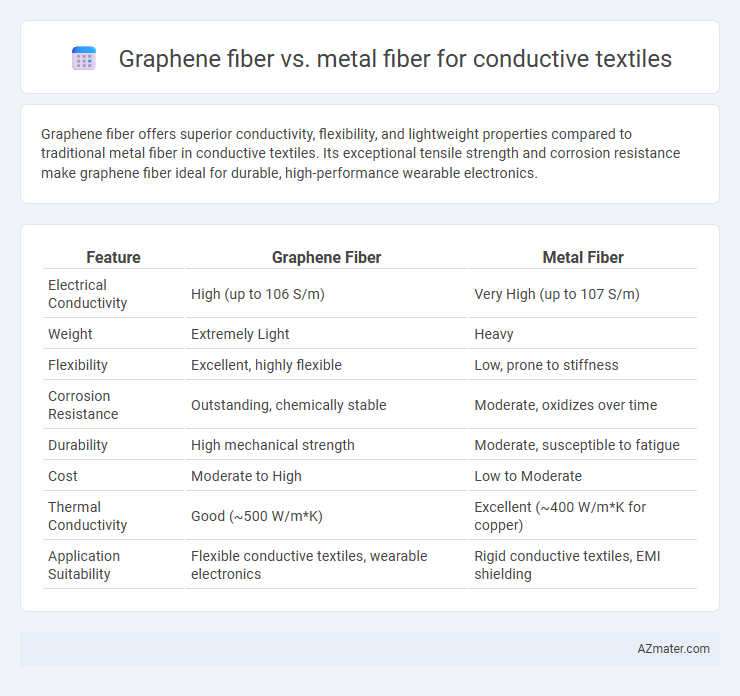Graphene fiber offers superior conductivity, flexibility, and lightweight properties compared to traditional metal fiber in conductive textiles. Its exceptional tensile strength and corrosion resistance make graphene fiber ideal for durable, high-performance wearable electronics.
Table of Comparison
| Feature | Graphene Fiber | Metal Fiber |
|---|---|---|
| Electrical Conductivity | High (up to 106 S/m) | Very High (up to 107 S/m) |
| Weight | Extremely Light | Heavy |
| Flexibility | Excellent, highly flexible | Low, prone to stiffness |
| Corrosion Resistance | Outstanding, chemically stable | Moderate, oxidizes over time |
| Durability | High mechanical strength | Moderate, susceptible to fatigue |
| Cost | Moderate to High | Low to Moderate |
| Thermal Conductivity | Good (~500 W/m*K) | Excellent (~400 W/m*K for copper) |
| Application Suitability | Flexible conductive textiles, wearable electronics | Rigid conductive textiles, EMI shielding |
Introduction to Conductive Textiles
Conductive textiles integrate materials like graphene fiber and metal fiber to enable electrical conductivity while maintaining fabric flexibility and comfort. Graphene fiber offers superior electrical conductivity, lightweight properties, and enhanced mechanical strength compared to traditional metal fibers such as copper or silver. These characteristics make graphene fiber a promising alternative in wearable electronics, smart textiles, and electromagnetic shielding applications.
What is Graphene Fiber?
Graphene fiber is a cutting-edge conductive textile material composed of graphene sheets arranged into flexible, lightweight strands with exceptional electrical conductivity and mechanical strength. Compared to traditional metal fibers like copper or silver, graphene fibers offer superior durability, corrosion resistance, and enhanced flexibility for wearable electronics and smart fabrics. Their unique two-dimensional carbon structure enables efficient electron mobility, making them ideal for advanced applications in flexible sensors, electromagnetic interference shielding, and energy storage devices.
What is Metal Fiber?
Metal fiber is a conductive material made by drawing metals like copper, silver, or stainless steel into fine threads used in textiles for electrical conductivity and electromagnetic shielding. These fibers offer high electrical conductivity and durability but can be heavier and less flexible compared to graphene fibers. Metal fibers are commonly integrated into fabrics for applications in wearable electronics, sensors, and smart textiles requiring robust conductivity.
Electrical Conductivity: Graphene vs Metal
Graphene fiber exhibits exceptional electrical conductivity, surpassing many traditional metal fibers due to its two-dimensional carbon lattice structure that allows electrons to move with minimal resistance. Metal fibers such as silver, copper, and aluminum offer high conductivity but suffer from weight and flexibility limitations compared to graphene. The superior conductivity-to-weight ratio of graphene fiber enhances performance in conductive textiles, enabling lightweight, flexible, and highly efficient electrical pathways.
Flexibility and Durability Comparison
Graphene fiber exhibits superior flexibility compared to metal fiber, maintaining conductivity under extensive bending and stretching without fracturing. Metal fibers, while offering high initial conductivity, tend to suffer from fatigue and cracking over repeated deformation, reducing their durability in textile applications. The intrinsic strength and resilience of graphene enhance the longevity of conductive textiles, making graphene fiber a more durable and flexible choice for wearable electronics.
Weight and Comfort in Wearable Applications
Graphene fiber offers significantly lower weight compared to metal fiber, enhancing the comfort and flexibility of conductive textiles in wearable applications. Its high tensile strength and superior conductivity allow for lightweight, breathable fabrics that reduce wearer fatigue. Metal fibers, while conductive, tend to add bulk and stiffness, making graphene fibers a preferred choice for ergonomic and comfortable smart clothing designs.
Corrosion Resistance and Longevity
Graphene fiber exhibits superior corrosion resistance compared to metal fiber in conductive textiles, maintaining electrical performance even in harsh environments. Unlike metal fibers, which are prone to oxidation and degradation over time, graphene's carbon-based structure ensures enhanced longevity and stable conductivity. This makes graphene fiber the preferred choice for durable, high-performance conductive textiles in demanding applications.
Manufacturing Processes and Scalability
Graphene fiber manufacturing involves chemical vapor deposition (CVD) and wet spinning techniques, enabling lightweight, flexible, and highly conductive textiles. Metal fibers typically use electrospinning or physical vapor deposition (PVD), which can be energy-intensive and less adaptable to large-scale production. Scalability favors graphene fibers due to lower material costs, faster production cycles, and compatibility with existing textile manufacturing infrastructure.
Environmental Impact and Sustainability
Graphene fiber, derived from carbon atoms arranged in a two-dimensional lattice, offers superior environmental benefits compared to traditional metal fibers due to its lightweight nature and reduced resource intensity during production. Metal fibers such as copper or silver often involve energy-intensive mining and refining processes, leading to higher carbon emissions and waste generation, whereas graphene fiber production can leverage greener synthesis methods with lower ecological footprints. The recyclability and biodegradability of graphene-based conductive textiles enhance sustainable lifecycle management, making them a more eco-friendly choice for modern wearable electronics.
Future Prospects and Industry Applications
Graphene fiber offers superior electrical conductivity, flexibility, and lightweight properties compared to traditional metal fibers, making it highly promising for next-generation conductive textiles in wearable electronics and smart fabrics. Its exceptional mechanical strength combined with corrosion resistance positions graphene fiber as a sustainable alternative for industrial applications requiring durability and high performance, such as aerospace and medical devices. Ongoing advancements in scalable production and integration techniques suggest graphene fiber will increasingly dominate conductive textile markets, driving innovation in flexible sensors, energy-harvesting garments, and advanced communication fabrics.

Infographic: Graphene fiber vs Metal fiber for Conductive textile
 azmater.com
azmater.com